Monitoring Wetland Landscape Evolution Using Landsat Time-Series Data: A Case Study of the Nantong Coast, China
Abstract
1. Introduction
2. Materials and Methods
2.1. Study Area
2.2. Dataset
2.3. Methods
2.3.1. Wetland Landscape Classification
2.3.2. Coastal Wetlands Interpretation
2.3.3. Landscape Change Analysis
3. Results
3.1. Spatial Distribution of Wetland Types
3.2. Change Rate and Dynamic Degree of the Nantong Coastal Wetland Types
3.3. Landscape Index Analysis
4. Discussion
4.1. Influence Factors
4.1.1. Influence of Natural Conditions
4.1.2. Impact of Reclamation
4.1.3. Difference in Economic Comparative Interests
4.2. The Importance and Future of the Nantong Coast
4.3. Deficiencies and Prospect of Our Study
5. Conclusions
- (1)
- The Nantong wetland type system was established, which was divided into three major categories: natural wetland landscapes, artificial wetland landscapes, and non-wetland landscapes, including 11 subcategories (reed marsh, thatched marsh, Suaeda salsa salt marsh, Spartina salt marsh, bare mudflat and offshore, river bank, breeding pond, salt pan, construction land, farmland and woodland, and others (abandoned land, reclamation of unused land, etc.)).
- (2)
- Natural wetlands, such as thatched and Suaeda salsa marshes, were extremely reduced, while artificial wetlands and non-wetland with high human activity, such as breeding ponds, farmland, and construction land, increased significantly in the Nantong coast. The two types of natural wetland vegetation showed opposite trends as a whole in the past 30 years. The area of salt marshes of Suaeda salsa shrunk rapidly, while the area of salt marshes of Spartina increased significantly.
- (3)
- In the past 30 years, due to the influence of environmental pressures such as population growth, land demand, and economic development, the major influencing factors of local landscape change shifted from natural geographical factors to human activities and economic as well as social factors. With the diversification of land use, the fragmentation of the coastal zone landscape increased, and the landscape presented a landscape change trend of multiadvantage development. Therefore, it is worth noting that reduced human activities and increased conservation as well as restoration efforts should be implemented to bring a stable increasing trend to the Nantong coastal wetlands.
Author Contributions
Funding
Institutional Review Board Statement
Informed Consent Statement
Data Availability Statement
Acknowledgments
Conflicts of Interest
References
- Costanza, R.; d’Arge, R.; de Groot, R.; Farber, S.; Grasso, M.; Hannon, B.; Limburg, K.; Naeem, S.; O’Neill, R.V.; Paruelo, J.; et al. The value of the world’s ecosystem services and natural capital. Nature 1997, 387, 253–260. [Google Scholar] [CrossRef]
- Costanza, R.; de Groot, R.; Sutton, P.; Van der Ploeg, S.; Anderson, S.J.; Kubiszewski, I.; Farber, S.; Turner, R.K. Changes in the global value of ecosystem services. Glob. Environ. Chang. 2014, 26, 152–158. [Google Scholar] [CrossRef]
- McLeod, E.; Chmura, G.L.; Bouillon, S.; Salm, R.; Björk, M.; Duarte, C.M.; Lovelock, C.E.; Schlesinger, W.H.; Silliman, B.R. A blueprint for blue carbon: Toward an improved understanding of the role of vegetated coastal habitats in sequestering CO2. Front. Ecol. Environ. 2011, 9, 552–560. [Google Scholar] [CrossRef]
- Teuchies, J.; Vandenbruwaene, W.; Carpentier, R.; Bervoets, L.; Temmerman, S.; Wang, C.; Maris, T.; Cox, T.J.S.; Braeckel, A.V.; Meire, P. Estuaries as filters: The role of tidal marshes in trace metal removal. PLoS ONE 2013, 8, e70381. [Google Scholar] [CrossRef]
- Schuerch, M.; Spencer, T.; Temmerman, S.; Kirwan, M.L.; Wolff, C.; Lincke, D.; McOwen, C.J.; Pickering, M.D.; Reef, R.; Vafeidis, A.T.; et al. Future response of global coastal wetlands to sea-level rise. Nature 2018, 561, 231–234. [Google Scholar] [CrossRef]
- Temmerman, S.; Meire, P.; Bouma, T.J.; Herman, P.M.J.; Ysebaert, T.; De Vriend, H.J. Ecosystem-based coastal defence in the face of global change. Nature 2013, 504, 79–83. [Google Scholar] [CrossRef]
- Aburto-Oropeza, O.; Ezcurra, E.; Danemann, G.; Valdez, V.; Murray, J.; Sala, E. Mangroves in the Gulf of California increase fishery yields. Proc. Natl. Acad. Sci. USA 2008, 105, 10456–10459. [Google Scholar] [CrossRef]
- Törnqvist, T.E.; Cahoon, D.R.; Morris, J.T.; Day, J.W. Coastal wetland resilience, accelerated sea-level rise, and the importance of timescale. AGU Adv. 2021, 2, e2020AV000334. [Google Scholar] [CrossRef]
- Couvillion, B.R.; Beck, H.; Schoolmaster, D.; Fischer, M. Land area change in coastal Louisiana (1932 to 2016). United States Geol. Surv. Sci. Investig. Map 2017, 3381, 1–16. [Google Scholar] [CrossRef]
- Wang, X.; Xiao, X.; Xu, X.; Zou, Z.; Chen, B.; Qin, Y.; Zhang, X.; Dong, J.; Liu, D.; Pan, L.; et al. Rebound in China’s coastal wetlands following conservation and restoration. Nat. Sustain. 2021, 4, 1076–1083. [Google Scholar] [CrossRef]
- Murray, N.J.; Phinn, S.R.; DeWitt, M.; Ferrari, R.; Johnston, R.; Lyons, M.B.; Clinton, N.; Thau, D.; Fuller, R.A. The global distribution and trajectory of tidal flats. Nature 2019, 565, 222–225. [Google Scholar] [CrossRef] [PubMed]
- Kirwan, M.L.; Megonigal, J.P. Tidal wetland stability in the face of human impacts and sea-level rise. Nature 2013, 504, 53–60. [Google Scholar] [CrossRef] [PubMed]
- Chen, C.; Feng, J.; Wang, C.; Mao, L.; Zhang, Y. Satellite-Based Monitoring of Coastal Wetlands in Yancheng, Jiangsu Province, China. J. Mar. Sci. Eng. 2022, 10, 829. [Google Scholar] [CrossRef]
- Yao, H. Characterizing landuse changes in 1990–2010 in the coastal zone of Nantong, Jiangsu province, China. Ocean Coast. Manag. 2013, 71, 108–115. [Google Scholar] [CrossRef]
- Cui, L.; Li, G.; Chen, Y.; Li, L. Response of Landscape Evolution to Human Disturbances in the Coastal Wetlands in Northern Jiangsu Province, China. Remote Sens. 2021, 13, 2030. [Google Scholar] [CrossRef]
- Ghosh, S.; Mishra, D.R.; Gitelson, A.A. Long-term monitoring of biophysical characteristics of tidal wetlands in the northern Gulf of Mexico—A methodological approach using MODIS. Remote Sens. Environ. 2016, 173, 39–58. [Google Scholar] [CrossRef]
- Cao, W.; Zhou, Y.; Li, R.; Li, X. Mapping changes in coastlines and tidal flats in developing islands using the full time series of Landsat images. Remote Sens. Environ. 2020, 239, 111665. [Google Scholar] [CrossRef]
- Li, W.; Gong, P. Continuous monitoring of coastline dynamics in western Florida with a 30-year time series of Landsat imagery. Remote Sens. Environ. 2016, 179, 196–209. [Google Scholar] [CrossRef]
- Wang, X.; Xiao, X.; Zou, Z.; Chen, B.; Ma, J.; Dong, J.; Doughty, R.B.; Zhong, Q.; Qin, Y.; Dai, S.; et al. Tracking annual changes of coastal tidal flats in China during 1986–2016 through analyses of Landsat images with Google Earth Engine. Remote Sens. Environ. 2020, 238, 110987. [Google Scholar] [CrossRef]
- Wang, X.; Xiao, X.; Zou, Z.; Hou, L.; Qin, Y.; Dong, J.; Doughty, R.B.; Chen, B.; Zhang, X.; Chen, Y.; et al. Mapping coastal wetlands of China using time series Landsat images in 2018 and Google Earth Engine. ISPRS J. Photogramm. Remote Sens. 2020, 163, 312–326. [Google Scholar] [CrossRef]
- Bagot, P.; Huybrechts, N.; Sergent, P. Satellite-Derived Topography and Morphological Evolution around Authie Macrotidal Estuary (France). J. Mar. Sci. Eng. 2021, 9, 1354. [Google Scholar] [CrossRef]
- Kanwal, S.; Ding, X.; Sajjad, M.; Nazeer, M.; Zia, I. Remote Sensing of Narrowing Barrier Islands along the Coast of Pakistan over Past 30 Years. J. Mar. Sci. Eng. 2021, 9, 295. [Google Scholar] [CrossRef]
- Li, Z.; Ren, Y.; Li, J.; Li, Y.; Rykov, P.; Chen, F.; Zhang, W. Land-Use/Cover Change and Driving Mechanism on the West Bank of Lake Baikal from 2005 to 2015—A Case Study of Irkutsk City. Sustainability 2018, 10, 2904. [Google Scholar] [CrossRef]
- Jia, M.; Wang, Z.; Mao, D.; Ren, C.; Wang, C.; Wang, Y. Rapid, robust, and automated mapping of tidal flats in China using time series Sentinel-2 images and Google Earth Engine. Remote Sens. Environ. 2021, 255, 112285. [Google Scholar] [CrossRef]
- Keshta, A.E.; Riter, J.C.A.; Shaltout, K.H.; Baldwin, A.H.; Kearney, M.; Sharaf El-Din, A.; Eid, E.M. Loss of Coastal Wetlands in Lake Burullus, Egypt: A GIS and Remote-Sensing Study. Sustainability 2022, 14, 4980. [Google Scholar] [CrossRef]
- Sun, C.; Liu, Y.; Zhao, S.; Zhou, M.; Yang, Y.; Li, F. Classification mapping and species identification of salt marshes based on a short-time interval NDVI time-series from HJ-1 optical imagery. Int. J. Appl. Earth Obs. Geoinf. 2016, 45, 27–41. [Google Scholar] [CrossRef]
- Phiri, D.; Morgenroth, J. Developments in Landsat Land Cover Classification Methods: A Review. Remote Sens. 2017, 9, 967. [Google Scholar] [CrossRef]
- Davranche, A.; Lefebvre, G.; Poulin, B. Wetland monitoring using classification trees and SPOT-5 seasonal time series. Remote Sens. Environ. 2010, 114, 552–562. [Google Scholar] [CrossRef]
- Mahdianpari, M.; Salehi, B.; Mohammadimanesh, F.; Motagh, M. Random forest wetland classification using ALOS-2 L-band, RADARSAT-2 C-band, and TerraSAR-X imagery. ISPRS J. Photogramm. Remote Sens. 2017, 130, 13–31. [Google Scholar] [CrossRef]
- Liu, M.; Mao, D.; Wang, Z.; Li, L.; Man, W.; Jia, M.; Ren, C.; Zhang, Y. Rapid Invasion of Spartina alterniflora in the Coastal Zone of Mainland China: New Observations from Landsat OLI Images. Remote Sens. 2018, 10, 1933. [Google Scholar] [CrossRef]
- Chen, C.; Ma, Y.; Ren, G.; Wang, J. Aboveground biomass of salt-marsh vegetation in coastal wetlands: Sample expanion of in situ hyperspectral and Sentinel-2 data using a generative adversarial network. Remote Sens. Environ. 2022, 270, 112885. [Google Scholar] [CrossRef]
- Wiberg, P.L.; Fagherazzi, S.; Kirwan, M.L. Improving predictions of salt marsh evolution through better integration of data and models. Annu. Rev. Mar. Sci. 2020, 12, 389–413. [Google Scholar] [CrossRef] [PubMed]
- Pavlovic, V.I.; Sharma, R.; Huang, T.S. Visual interpretation of hand gestures for human-computer interaction: A review. IEEE Trans. Pattern Anal. Mach. Intell. 1997, 19, 677–695. [Google Scholar] [CrossRef]
- Ren, M. Comprehensive Investigation of Coastal Zone and Tidal Flat Resources, Jiangsu Province; Ocean Press: Beijing, China, 1986; pp. 122–134. (In Chinese) [Google Scholar]
- Wang, Y.; Zhu, D.; You, K.; Pan, S.; Zhu, X.; Zou, X.; Zhang, Y. Evolution of radiative sand ridge field of the South Yellow Sea and its sedimentary characteristics. Sci. China Ser. D 1999, 42, 97–112. [Google Scholar] [CrossRef]
- Liu, Y.X.; Li, M.C.; Zhou, M.X.; Kang, Y.; Mao, L. Quantitative Analysis of the Waterline Method for Topographical Mapping of Tidal Flats: A Case Study in the Dongsha Sandbank, China. Remote Sens. 2013, 5, 6138–6158. [Google Scholar] [CrossRef]
- Yao, P.; Su, M.; Wang, Z.; Rijn, L.C.V.; Zhang, C.; Chen, Y.; Stive, M.J.F. Experiment inspired numerical modeling of sediment concentration over sand–silt mixtures. Coast. Eng. 2015, 105, 75–89. [Google Scholar] [CrossRef]
- Liu, T.; Shi, X.; Li, C.; Yang, G. The reverse sediment transport trend between abandoned Huanghe River (Yellow River) Delta and radial sand ridges along Jiangsu coastline of China—An evidence from grain size analysis. Acta Oceanol. Sin. 2012, 31, 83–91. [Google Scholar] [CrossRef]
- Zhang, C.; Zhang, D.; Zhang, J.; Wang, Z. Tidal current-induced formation-storm-induced change-tidal current-induced recovery-Interpretation of depositional dynamics of formation and evolution of radial sand ridges on the Yellow Sea seafloor. Sci. China (Ser. D Earth Sci.) 1999, 42, 1–12. [Google Scholar] [CrossRef]
- Kang, Y.; Ding, X.; Xu, F.; Zhang, C.; Ge, X. Topographic mapping on large-scale tidal flats with an iterative approach on the waterline method. Estuar. Coast. Shelf Sci. 2017, 190, 11–22. [Google Scholar] [CrossRef]
- Chen, K.F.; Wang, Y.H.; Lu, P.D.; Zheng, J.H. Effects of Coastline Changes on Tide System of Yellow Sea off Jiangsu Coast, China. China Ocean Eng. 2009, 23, 741–750. [Google Scholar]
- The 908 Special Office in Jiangsu Province. General Report of a Marine Comprehensive Survey and Evaluation of Jiangsu; Science Press: Beijing, China, 2012; pp. 550–612. (In Chinese) [Google Scholar]
- Zhang, M.; Pu, L. The changing process of coastal wetlands and the effects of reclamation in Jiangsu Province in recent 30 years. Wetl. Sci. Manag. 2017, 13, 56–60. (In Chinese) [Google Scholar] [CrossRef]
- Kang, Y.; He, J.; Wang, B.; Lei, J.; Wang, Z.; Ding, X. Geomorphic Evolution of Radial Sand Ridges in the South Yellow Sea Observed from Satellites. Remote Sens. 2022, 14, 287. [Google Scholar] [CrossRef]
- Committee on Characterization of Wetlands; Water Science and Technology Board; Board on Environmental Studies and Toxicology; Commission on Geosciences, Environment, and Resources; National Research Council. Wetlands: Characteristics and Boundaries; National Academy Press: Washington, DC, USA, 1995; pp. 124–125. [Google Scholar]
- Rogan, J.; Chen, D. Remote sensing technology for mapping and monitoring land-cover and land-use change. Prog. Plan. 2004, 61, 301–325. [Google Scholar] [CrossRef]
- O’Neill, R.V.; Krummel, J.R.; Gardner, R.H.; Sugihara, G.; Jackson, B.; De Angelis, D.L.; Milne, B.T.; Turner, M.G.; Zygmunt, B.; Christensen, S.W.; et al. Indices of landscape pattern. Landsc. Ecol. 1988, 1, 153–162. [Google Scholar] [CrossRef]
- Alberti, M.; Waddell, P. An integrated urban development and ecological simulation model. Integr. Assess. 2000, 1, 215–227. [Google Scholar] [CrossRef]
- Liu, X.; Li, X.; Chen, Y.; Tan, Z.; Li, S.; Ai, B. A new landscape index for quantifying urban expanion using multi-temporal remotely sensed data. Landsc. Ecol. 2010, 25, 671–682. [Google Scholar] [CrossRef]
- Historical Records of Nantong. Available online: http://www.ntszw.gov.cn/?c=index&a=show&id=1900 (accessed on 11 September 2022). (In Chinese)
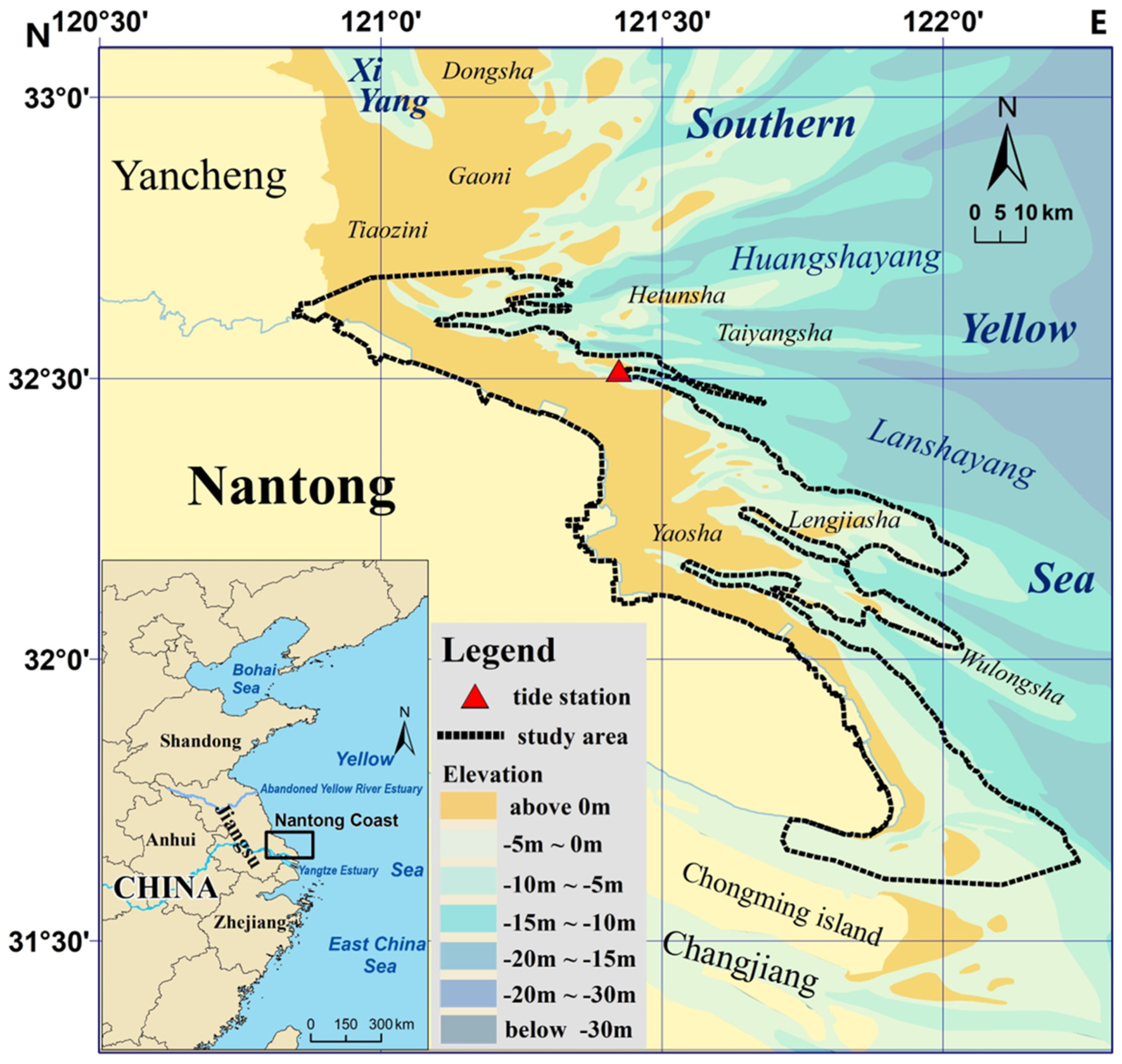
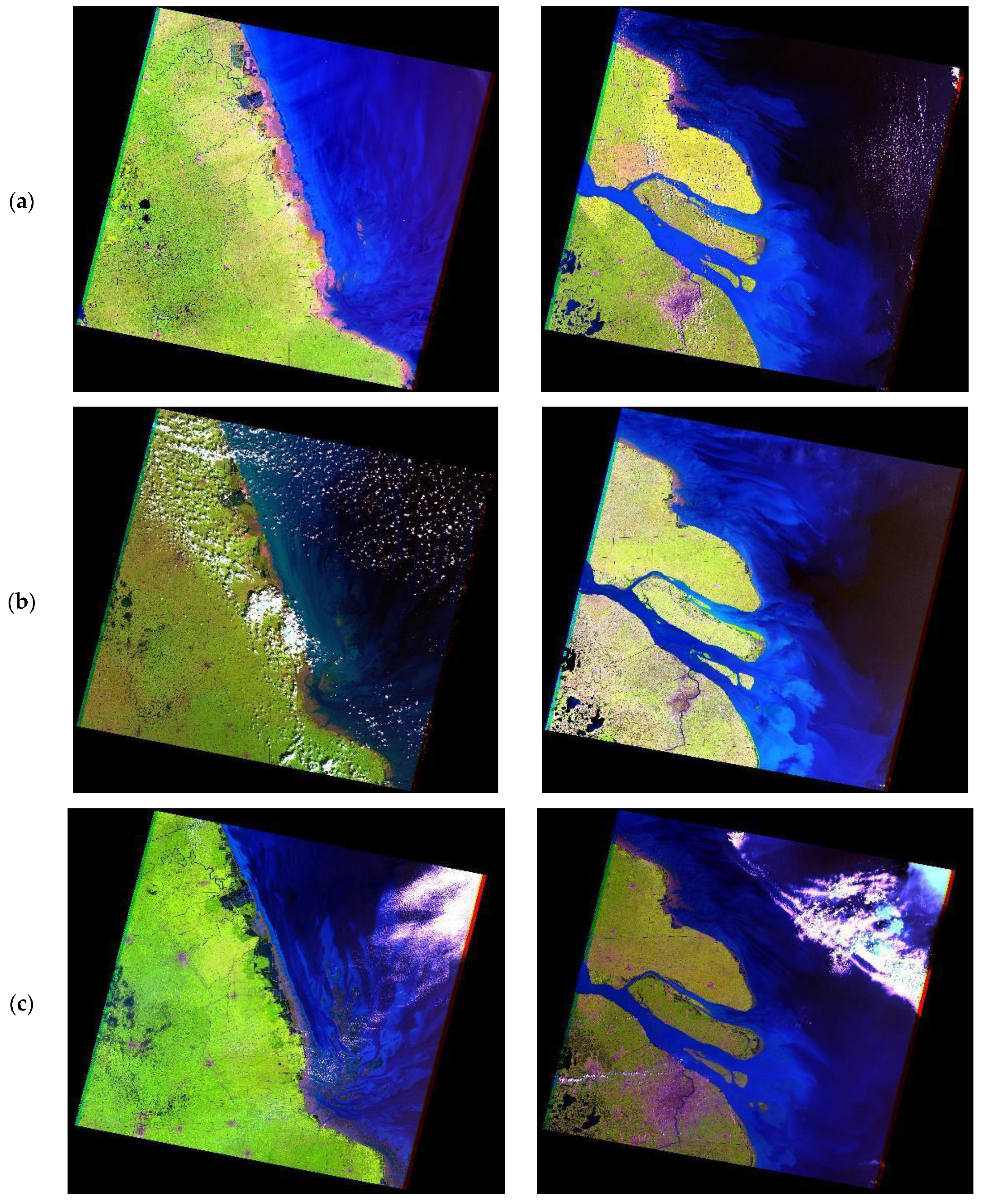
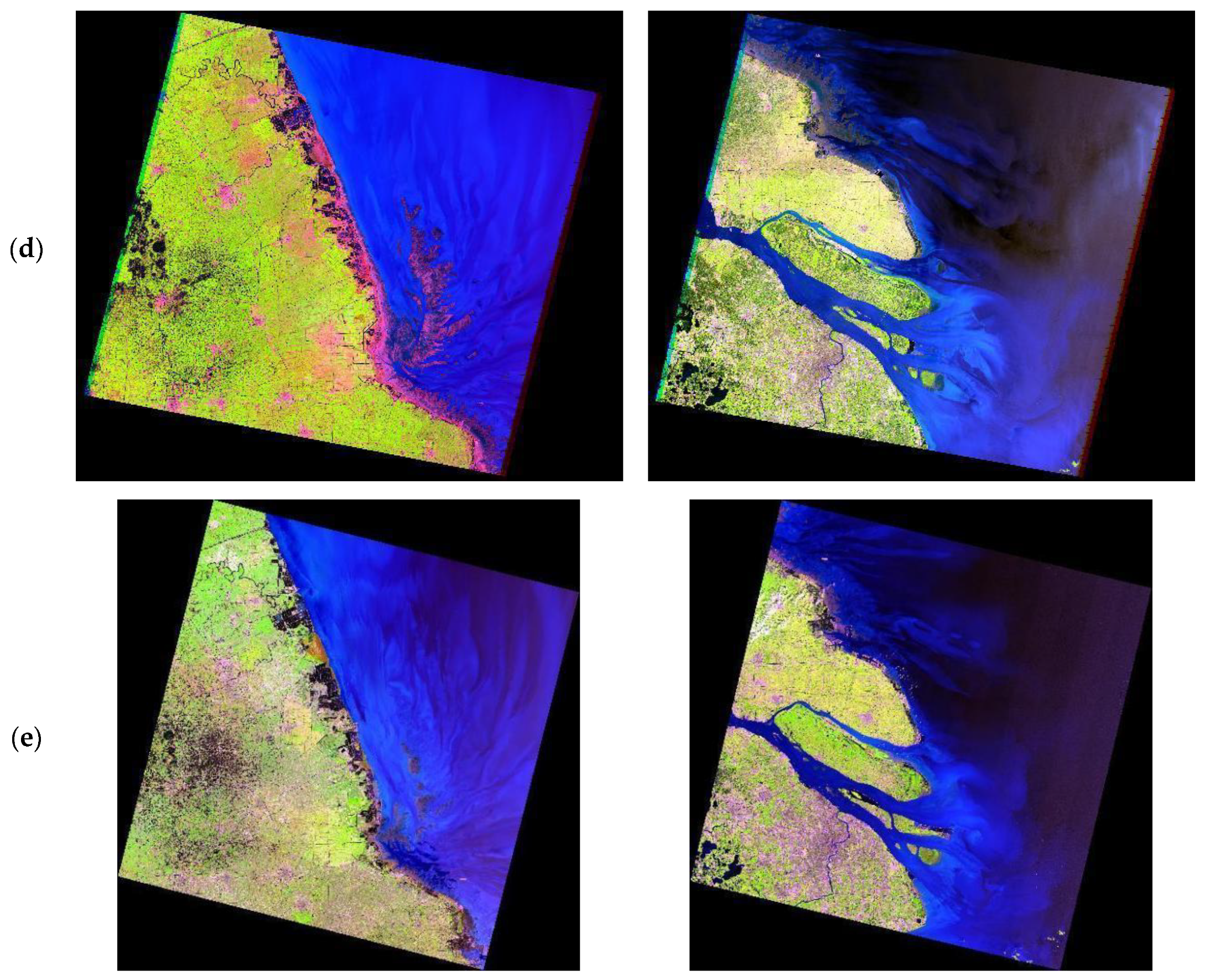

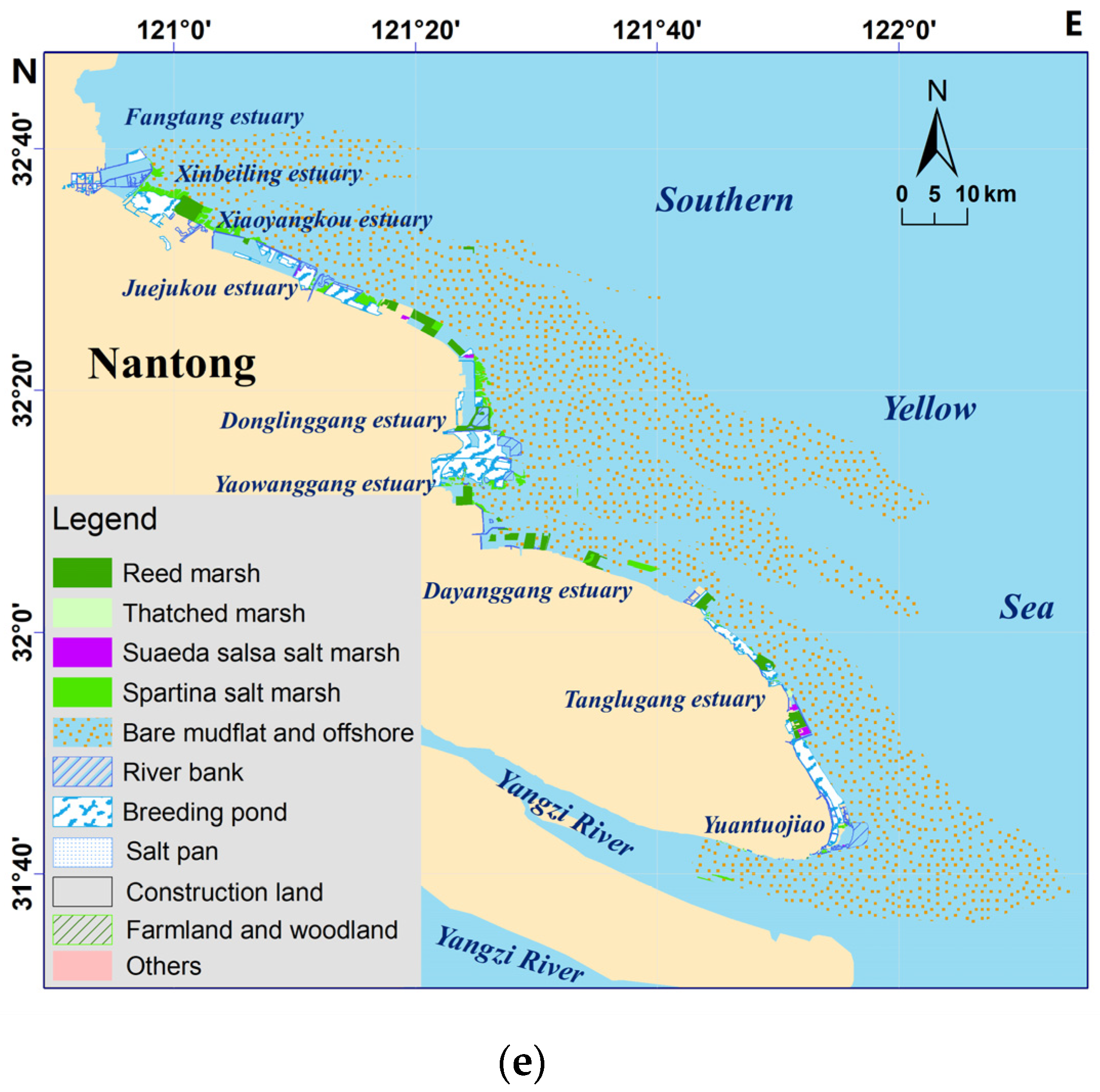

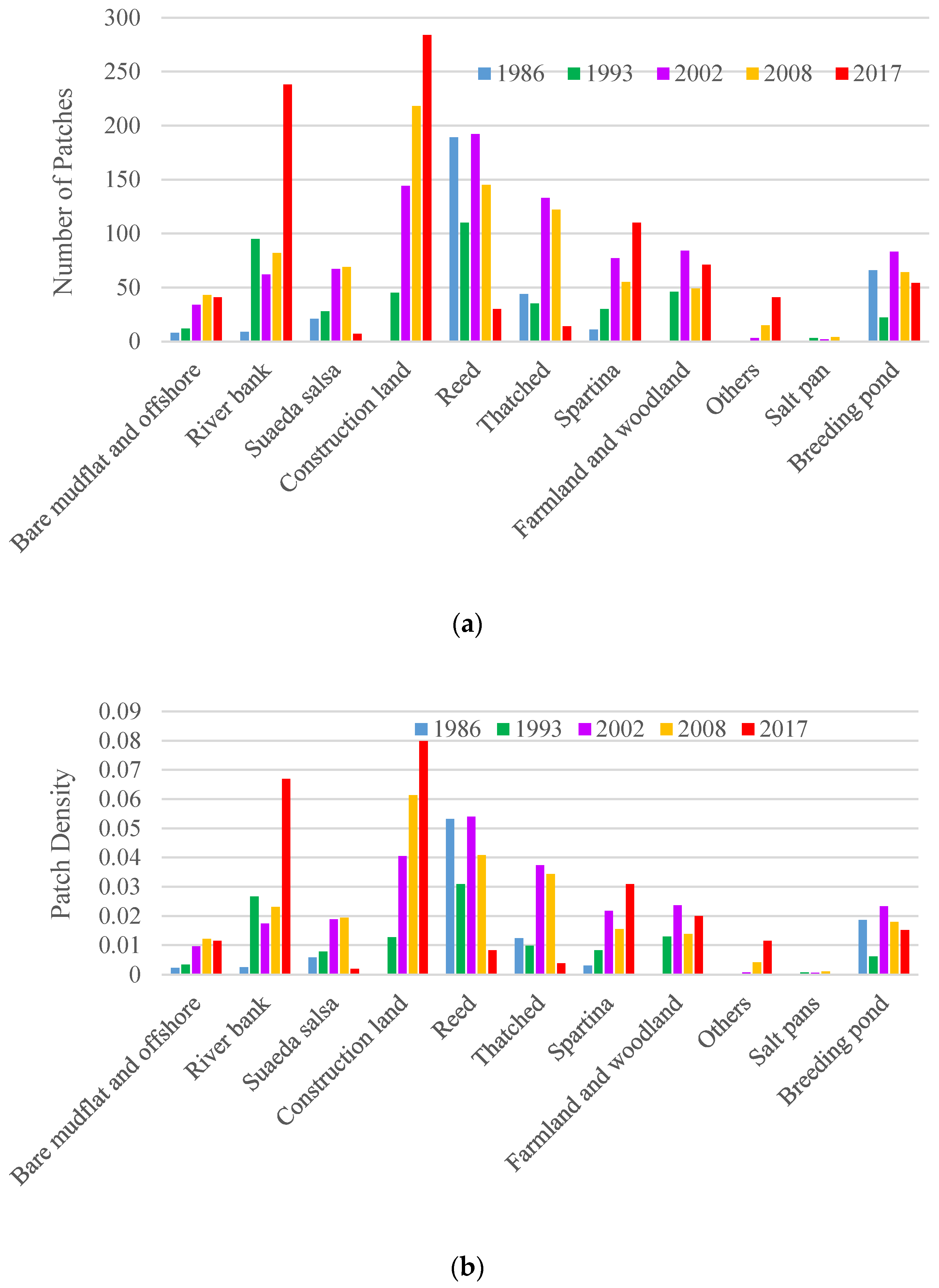

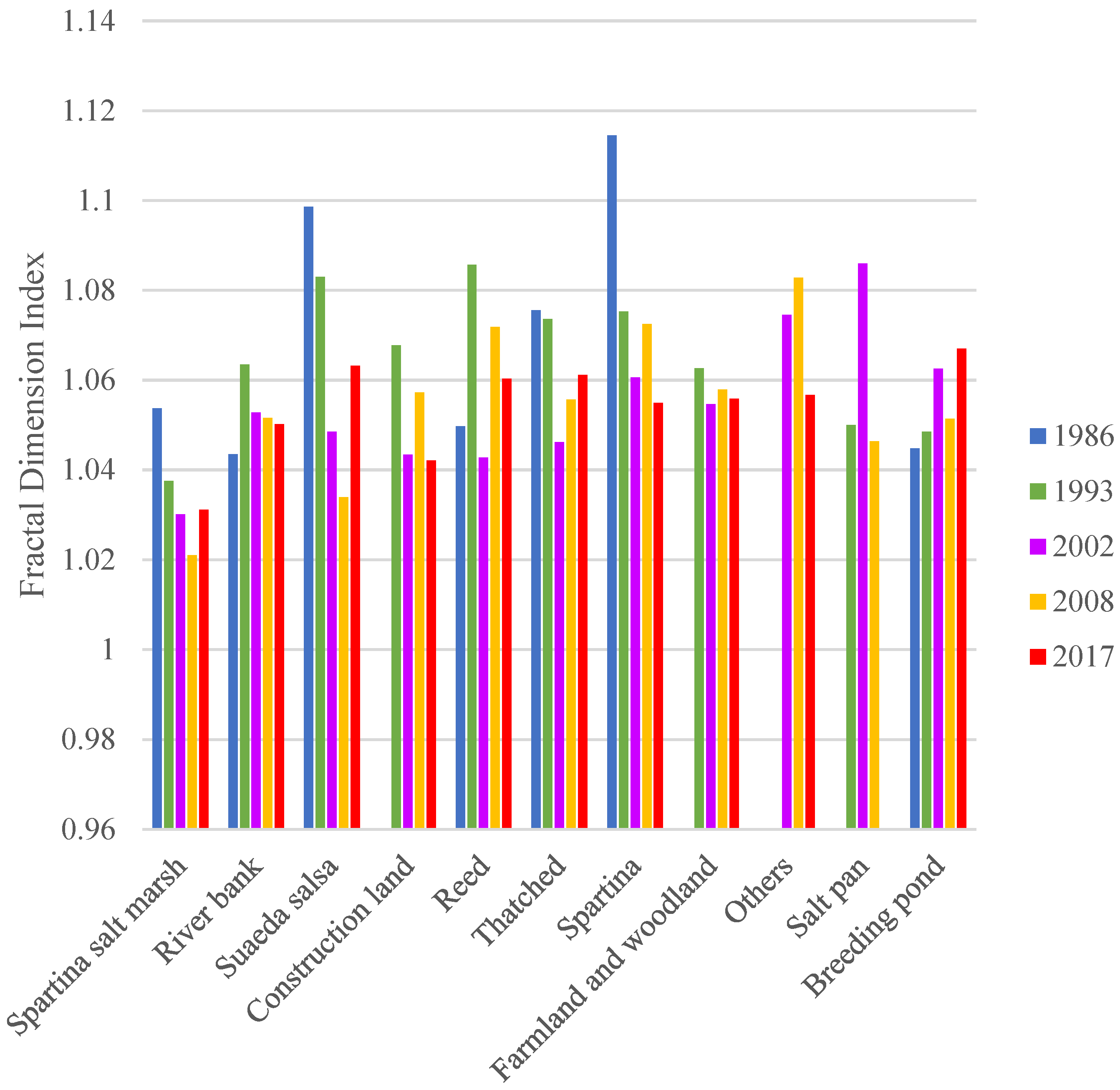
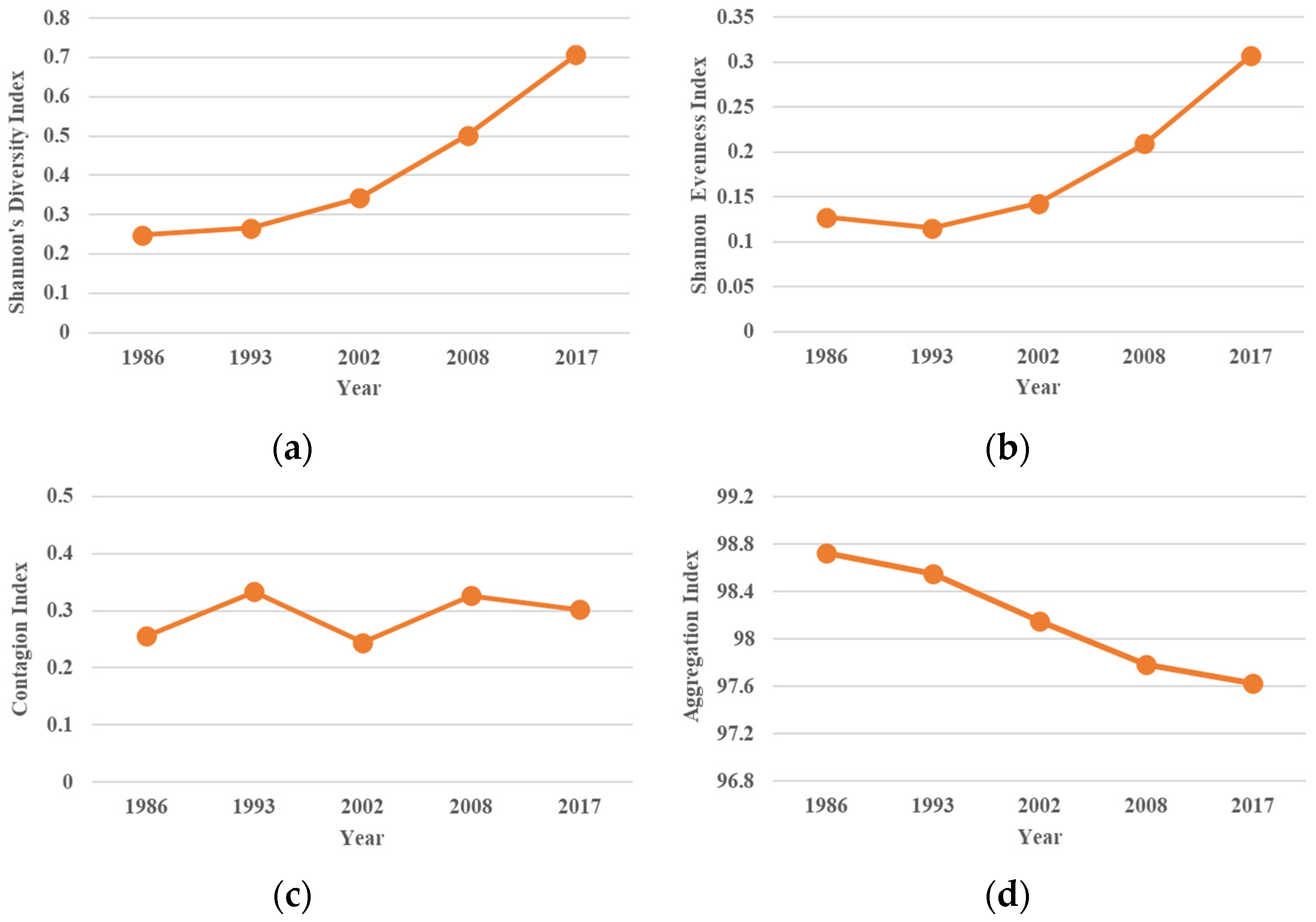
| Date | Satellite | Sensor | WRS-2 | Tide Level/m |
|---|---|---|---|---|
| Path/Row | Yangkougang | |||
| 19 August 1986 | Landsat-5 | TM | 118/38 | −2.14 |
| 22 May 1986 | Landsat-5 | TM | 119/37 | −2.40 |
| 3 June 1993 | Landsat-5 | TM | 118/38 | −2.02 |
| 30 September 1993 | Landsat-5 | TM | 119/37 | −1.92 |
| 23 August 2002 | Landsat-7 | ETM+ | 118/38 | −1.85 |
| 29 July 2002 | Landsat-7 | ETM+ | 119/37 | −2.10 |
| 6 July 2008 | Landsat-7 | ETM+ | 118/38 | −1.97 |
| 24 April 2008 | Landsat-7 | ETM+ | 119/37 | −1.82 |
| 24 August 2017 | Landsat-8 | OLI | 118/38 | −1.83 |
| 27 May 2017 | Landsat-8 | OLI | 119/37 | −1.94 |
| Land Use/Landscape | Wetland | Wetland Community |
|---|---|---|
| Natural wetlands | Coastal wetlands | Reed marsh |
| Thatched marsh | ||
| Suaeda salsa salt marsh | ||
| Spartina salt marsh | ||
| Bare mudflat and offshore | ||
| River wetland | River bank | |
| Artificial wetland | ------ | Breeding pond |
| Salt pan | ||
| Non-wetland | ------ | Construction land |
| Farmland and woodland | ||
| Others (abandoned land, reclamation of unused land, etc.) |
| Wetland Community Type | Remote Sensing Image (RGB: Swir, Near-Infrared, and Red Bands) | Field Verification Photos |
|---|---|---|
| Reed marsh | 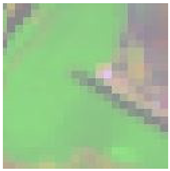 | 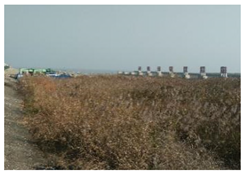 |
| Thatched marsh | 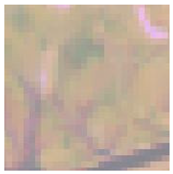 | 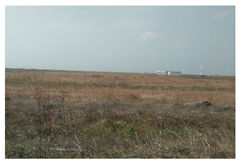 |
| Suaeda salsa salt marsh |  | 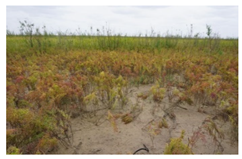 |
| Spartina salt marsh |  | 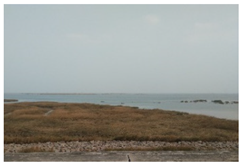 |
| Bare mudflat and offshore |  |  |
| River bank |  | 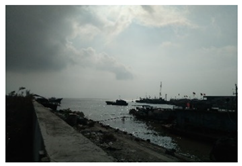 |
| Breeding pond | 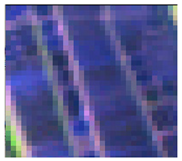 | 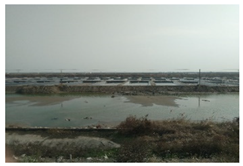 |
| Salt pan | 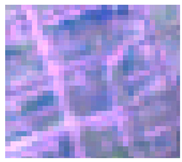 | 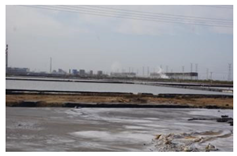 |
| Construction land |  | 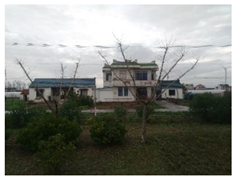 |
| Farmland and woodland |  | 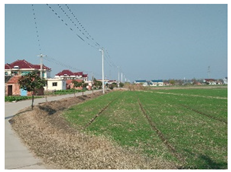 |
| Wetland Type | 1986–1993 | 1993–2002 | 2002–2008 | 2008–2017 | Average |
|---|---|---|---|---|---|
| Spartina salt marsh | −0.7% | −1.8% | 6.1% | −2.8% | 0.2% |
| Reed and thatched marsh | 0.4% | −2.4% | 6.2% | 1.4% | 1.4% |
| Suaeda salsa salt marsh | −8.8% | −2.8% | −53.9% | −14.6% | −20.0% |
| Bare mudflat and offshore | 0.0% | −0.2% | −0.6% | −0.7% | −0.4% |
| River bank | 13.6% | −2.7% | 12.9% | 4.4% | 7.0% |
| Breeding pond | −5.2% | 10.6% | 6.8% | 4.2% | 4.1% |
| Salt pan | 14.3% | 3.9% | 6.8% | 0.0% | 6.2% |
| Construction land | 14.3% | −0.1% | 12.9% | 6.4% | 8.4% |
| Farmland and woodland | 14.3% | 7.2% | 3.7% | 6.0% | 7.8% |
| Others | 0.0% | 11.1% | 12.5% | 8.1% | 7.9% |
Publisher’s Note: MDPI stays neutral with regard to jurisdictional claims in published maps and institutional affiliations. |
© 2022 by the authors. Licensee MDPI, Basel, Switzerland. This article is an open access article distributed under the terms and conditions of the Creative Commons Attribution (CC BY) license (https://creativecommons.org/licenses/by/4.0/).
Share and Cite
Wang, M.; Kang, Y.; Sun, Z.; Lei, J.; Peng, X. Monitoring Wetland Landscape Evolution Using Landsat Time-Series Data: A Case Study of the Nantong Coast, China. Sustainability 2022, 14, 13718. https://doi.org/10.3390/su142113718
Wang M, Kang Y, Sun Z, Lei J, Peng X. Monitoring Wetland Landscape Evolution Using Landsat Time-Series Data: A Case Study of the Nantong Coast, China. Sustainability. 2022; 14(21):13718. https://doi.org/10.3390/su142113718
Chicago/Turabian StyleWang, Minjing, Yanyan Kang, Zhuyou Sun, Jun Lei, and Xiuqiang Peng. 2022. "Monitoring Wetland Landscape Evolution Using Landsat Time-Series Data: A Case Study of the Nantong Coast, China" Sustainability 14, no. 21: 13718. https://doi.org/10.3390/su142113718
APA StyleWang, M., Kang, Y., Sun, Z., Lei, J., & Peng, X. (2022). Monitoring Wetland Landscape Evolution Using Landsat Time-Series Data: A Case Study of the Nantong Coast, China. Sustainability, 14(21), 13718. https://doi.org/10.3390/su142113718







